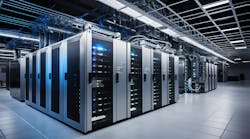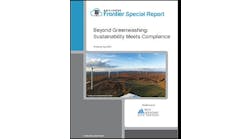The blue-lit corridors of Equinix colocation centers will soon be getting a new look. Seeking further gains in energy efficiency, Equinix is adopting a new data center design that reworks its approach to cooling.
The new design embraces aisle containment and recent advances in cooling, and will debut in Equinix data center projects that come online in 2017. The company expects these new facilities to be its most efficient yet, while providing a consistent experience for customers.
The new design is the latest chapter in the colocation industry’s effort to become better stewards of electricity and water use. As the economy shifts to digital delivery models, data centers are emerging as key engines of the global economy.
That’s especially true for Equinix, which is the world’s largest colocation provider. The company operates 10 million square feet of data center space in 145 facilities spread across 40 countries.
Over the past year the company has sharpened its focus on sustainability, committing to the use of renewable energy across its global platform. At the same time, it has been developing plans for an even more energy-friendly data center design.
Moving to the Next Level of Efficiency
The redesign project has two goals: improving energy efficiency, and maintaining exceptional reliability.
“These two priorities are at the heart of everything we do at Equinix,” said Raouf Abdel, Regional Operating Chief, Americas for Equinix. “We’re always assessing new technologies and new opportunities.
“The catalyst in this next evolution of our design is trying to be more efficient,” Abdel added. “We want to always push the envelope on efficiency, but we never want to do anything to impact our reliability. That’s what our customers expect from us.”
The overhead cooling ducts, like these in the Equinix NY4 facility in Secaucus, New Jersey, will be eliminated in the new design. (Photo: Rich Miller)
Equinix has long been known for housing equipment on a slab floor, introducing cool air into the data hall from overhead ducts rather than through a raised floor. The slab floor will remain, but the new design introduces several notable changes.
The new Equinix data centers will optimize the entire building around the cooling system. The design will feature indirect evaporative cooling, an approach that uses cool outside temperature to support the cooling system, but doesn’t introduce fresh air directly into the data hall.
Abdel said indirect evaporative cooling is extremely energy efficient, works in warm climates, and performs well in low load conditions (for example, during the early days of data center ramp-up). It also uses far less water than traditional data center designs that use chillers, and avoids the risk of outside contaminants entering the servers.
“We’ve been reviewing and analyzing this type of design for some time,” said Abdel. “It was only being used at a few facilities, and we waited a bit to see it in action in more of the market.”
Building Up: A Two-Story Colo Center
The design template is a two-story, 200,000 square foot rectangular structure, with the dimensions carefully calculated to perfect the airflow. Packaged IDECs (indirect evaporative cooling units) line the perimeter of one side of the building, with the emergency backup generators on the other side. The IDEC units attach to the building through large openings in the wall, and pump cool air into an interior plenum.
Abdel hinted at the redesign in a recent blog post which discussed the benefits of “fan walls,” but said the term had caused some confusion, as the vertical air plenum wall will be lined with louvers rather than fans. The louvers can be adjusted to control the airflow into the data hall.
A long row of colocation cages inside the Equinix SV5 data center in San Jose, Calif. (Photo: Rich Miller)
The design uses hot aisle containment, which is a new feature for Equinix. As exhaust air exits the rear of the servers, it rises through a chimney system and enters an overhead plenum, where it is returned to the IDEC units.
“It’s a very efficient design from many perspectives,” said Abdel. “The whole building is designed as an integrated design. It’s very efficient with space. We don’t use any of the building floor space for the cooling units, as that’s valuable real estate for us. Because it’s a low pressure system, it’s super quiet.”
That will be a welcome change from data halls that often resemble noisy wind tunnels. Air pressure is the key ingredient in directing airflow within the data hall so that cool air reaches the inlets of all the racks.
Equinix has used computational fluid dynamics software to guide its pressure and airflow assumptions. “We’ve done a lot of airflow modeling using CFD,” said Abdel.
Coming in 2017
The new buildings will have data halls on both floors, with dedicated cooling and air return plenums for each level. To cool the upper floor, Equinix will stack the IDEC units on the outside of the building.
There will be no heavy equipment on the roof of the building, which eliminates the need for roof penetrations, which can sometimes become sources of leaks.
“This is actually a very important issue for a data center, particularly in an environment where that’s wide variations in the weather,” said Abdel.[clickToTweet tweet=”Raouf Abdel of Equinix: ‘Containment has become essential. It is the next step in the game.'” quote=”Raouf Abdel of Equinix: ‘Containment has become essential. It is the next step in the game.'”]
The new designs will be implemented in several data center projects that will break ground this year and be completed in 2107. The company hasn’t yet announced the locations, but Abdel noted that the indirect cooling system can work well in many climates. To manage cooling on extremely warm days, the IDEC units include a DX cooling capability, using refrigerants to provide “trim cooling.”
The net effect will be a PUE in the range of 1.2 to 1.3, compared to the current 1.4 to 1.6, and PUEs up to 1.8 for older Equinix facilities. “We’re always looking at how to improve PUE in our design,” said Abdel, calling the new approach “the next generation of efficiency.”
The Road Ahead
The redesign is optimized for “greenfield” construction projects in suburban areas, and won’t apply to new space deployed in urban central business districts. Equinix also has no plans to retrofit existing facilities.
Abdel said Equinix will work closely with its 6,250 customers to help them get comfortable with the new design. It is part of an ongoing effort to help customers understand the importance of efficiency. Many Equinix customers are extremely sophisticated about data center operations. But in some cases, the company has had to emphasize the importance of best practices in deployment, such as maintaining proper positioning of servers and storage in a facility using hot and cold aisles.
FUll fiber trays inside Equinix DC11, one of the newest facilities inside the company’s 500,000 square foot campus in Ashburn. (Photo; Equinix)
“We’ve been on this journey for about 5 years now,” said Abdel. “We have been through an education process with our customers. Now because of the increased rack density, containment has become essential. It is the next step in the game. It creates a few more inconveniences with cabling, but over the course of a few years we’ve come to understand these quite well.”
Equinix isn’t the first multi-tenant provider to shift to continment. Last year DuPont Fabros Technology introduced a new design built around hot aisle containment, and reported a smooth transition for customers.
Most importantly, Abdel said, the new design will mean no change in the company’s focus on reliability. Equinix had “six nines” (99.9999 percent) uptime in 2014.
“It’s really not going to create any material change for customers in how they use our space,” said Abdel. “It will look and feel a lot like the same Equinix.”






